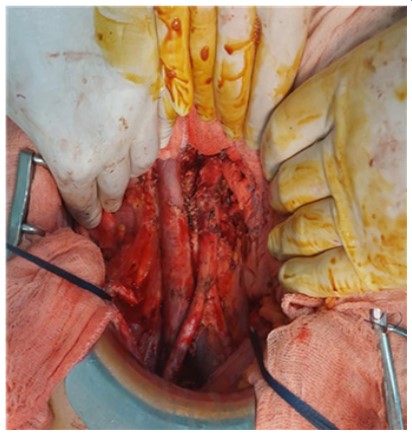
Journal of Gastroenterology Research and Practice
Clinical Image - Open Access, Volume 3
Lumbo-aortic lymphadenectomy for residuel retroperitoneal masses in testicular germ cell tumors
Tlili Yassine*; Osmane Rania; Hadrich Zied; Omrani Sahir Bayar Rached
Department of General surgery, Mongi Slim University Hospital, Faculty of medicine of Tunis, Tunisia.
*Corresponding Author : Tlili Yassine
Department of General surgery, Mongi Slim University
Hospital, Faculty of medicine of Tunis, Tunisia.
Email: yessinetlili24@gmail.com
Received : Jan 20, 2023
Accepted : Feb 21, 2023
Published : Feb 28, 2023
Archived : www.jjgastro.com
Copyright : © Yassine T (2023).
Keywords: Testicular germ cell tumors (TGCT); orchiectomy; BEP chemotherapy; lumbo-aortic lymphadenectomy.
Citation: Yassine T, Rania O, Zied H, Rached OSB. Lumbo-aortic lymphadenectomy for residuel retroperitoneal masses in testicular germ cell tumors. J Gastroenterol Res Pract. 2023; 3(1): 1128.
Clinical image description
It is about a 24-year-old male, with no past medical history, diagnosed in April 2021 with left testicular germ cell tumor. He had a left orchiectomy.
Postoperative thoraco-abdomino-pelvic CT scan showed inter-aorto-caval and pre-caval lymph nodes with a diameter of 31mm and 23mm respectively.
He received three cycles of BEP.
The post-chemotherapy CT scan showed tumor progression: appearance of mediastinal adenomegaly with a magma of retroperitoneal necrotic adenomegaly compressing the inferior vena cava and renal veins.
He received 4 cycles of TIP and was operated six weeks after the end of chemotherapy.
Peroperatively, it was a pre-aortic and inter-aorto caval magma adhering to the duodenum, to the renal pedicles, to the inferior mesenteric artery and to the spine.
He had a bilateral lumbo-aortic lymphadenectomy leaving a border adhering to the spine.
The postoperative follow-up was simple.
The anatomopathological examination concluded to a lymph node metastasis of a testicular germ cell tumors.
Regression of residual masses of TGCT is usually delayed.
In case of residual mass over 3 cm or progression under chemotherapy, surgical resection is recommended.
The morbidity associated with lumbo-aortic lymphadenectomy is due to the damage done to the sympathetic nerve fibers of the hypogastric plexus during the procedure.
However, it remains the reference curative surgical treatment of residual masses in testicular cancer.


